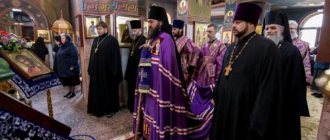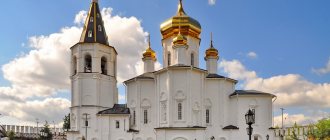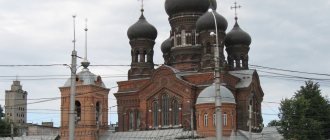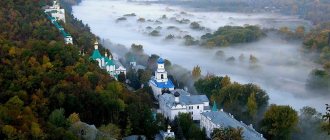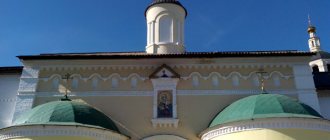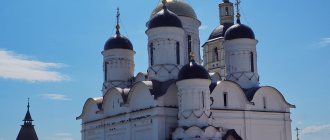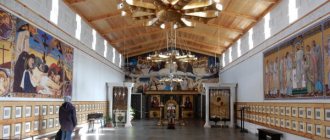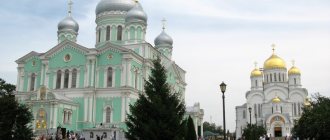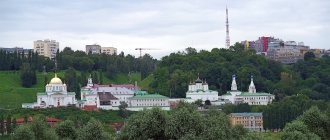The St. George Monastery has stood on the rocks of Cape Fiolent for more than a thousand years, as if protecting the peace of this place. Neither the Genoese nor the Turks, who came to Crimea as new owners in the Middle Ages, touched the shrine. Only after the revolution the monastery ceased its activities.
Photo of the monastery:
History of the shrine
Nobody knows when this unique Orthodox building first appeared on Fiolent.
The Chronicles of Genoa say that in the 14th century the monastery already stood on the cape, which became the outskirts of the consulate of Cembalo (today's Balaclava). In 1475, the Turks did not destroy it - the temple complex was under the jurisdiction of the Patriarchate of Constantinople. 1794 was the time when the men's monastery came under the care of the Holy Synod of the Russian Orthodox Church. Already under the Russians, the local elder Kalinnik continued his asceticism.
By that time, Sevastopol began to expand. St. George's Monastery was revered by the entire population of the large city located next door. It was then called Balaklava - the Crimean capital at the end of the 18th century did not go so far to the east, and Balaklava, hidden in a neighboring bay, was only 4 km away. By the time of the Crimean War, the monastery had grown several times. Even after this and the Great Patriotic War, something remained of it. This refers to the two-story cave buildings of the Church of the Nativity.
Opening hours for visitors
The territory of the monastery is open to the public from 6:00 to 22:00 daily. In addition to the opportunity to visit the nearby area, you can also attend a church service.
| Monday Friday | 7:00 – prayer service 8:00 – Divine Liturgy 16:00 – evening service |
| Saturday | 7:00 – prayer service 8:00 – Divine Liturgy 16:00 – All-night vigil |
| Sunday | 8:00 – prayer service 8:30 – Divine Liturgy 16:00 – evening service with akathist |
Legends about the temple on Fiolent
One of the old legends tells about an event in 890 -
when Chersonesus was part of Byzantium. On Fiolent, local fishermen became victims of a shipwreck in bad weather. Then the cape was called Parthenium (“place of the Virgin”). Having lost all hope, the fishermen appealed to the Great Martyr St. George the Victorious. He heard them and saved them, giving them a gift in memory of what happened. The next day, the townspeople carved a small temple into the rock and placed the icon given to them there.
Some of the rescued began to live in a cave - people became ascetics. The myth says - thus, the forerunner of the current men's monastery was born. By the way, the celestial being appeared on the reef - the place was called the Rock of the Apparition of the Saint. It is still visible both from water and from land. Many centuries later, Russian ascetics settled in the rock church. In an incomprehensible way, the Victorious filled not only them, but also the Russian sailors with courage and determination. After visiting the monastery, people heard the voice of the saint.
Read: Sights of Cape Fiolent
Patronal holidays[edit]
Nativity
- Jan. 7
Exaltation of the Life-Giving Cross of the Lord
- September 27
Icon of the Most Holy Theotokos “Iverskaya”
— October 26, February 25, May 6
Andrew the First-Called, Apostle
- December 13th
St. George the Victorious, Great Martyr
- the 6th of May
Cathedral of Crimean Saints
- December 28th
What attracts tourists to the St. George's Monastery?
The above-ground St. George's Monastery on Fiolent in its current appearance appeared to the eyes of Crimeans only in 2008. The building is a genuine reconstruction of a structure erected in 9-14. century before last (demolished under Soviet rule). It was built according to all the canons of Russian classicism. The interior decoration was decorated with lithographs by some of the best European artists. Now the interior is, of course, different. However, two fraternal complexes, the St. George Fountain, a bell tower, an elongated refectory, a rotunda gazebo and a chapel have been restored.
Now the majority of the described complex is located on the base of one of the military units of the Russian Black Sea Fleet.
At this point it is appropriate to mention that St. George is traditionally considered in Russia to be the “source” of victory. Sevastopol was in a state of siege several times - the sailors and soldiers stationed in the city needed Victoria constantly. Since 1813, the monastery even received the “rank” of a naval monastery - the monks who had lived here for 7 years began to serve as chaplains on warships. Many of them fought themselves, becoming famous heroes and examples for modern cadets.
Within this place of sacraments are the ruins of the archive and the monastery cemetery, where such famous monks as Chrysanthos of Novopatras and Agathangelus Tipaldo (both of whom were abbots of the monastery at the end of the 18th century) are buried. The objects once built by Russian monks include the site in front of the source of St. George, as well as the staircase starting from here, which at the end of the 19th century had 891 steps. Even now it is the longest man-made descent on the peninsula. As you approach Jasper Beach, you will be greeted by the ruins of the tiny mansion of Admiral Lazarev.
Don't miss: Review of the new park near the St. George's Monastery
The church at this landmark of Sevastopol is considered active and gives spiritual bliss to a huge number of parishioners and guests. The schedule of services can be found just outside the gate. Entry in beachwear is prohibited. Women should appear at the porch and porch with their heads already covered.
Information for pilgrims
You can get to the monastery both during an individual visit and on a trip around Fiolent, designed for several days. This is, for example, the “Ancient Greek Sevastopol” excursion, designed for a 3-day trip around the cape. The monastery is active, so some rules are followed.
Those visiting the monastery are not allowed to enter the territory in beach or open clothes, short pants, women must wear a hat. If necessary, closed clothing can be taken from the monastery itself at the entrance. A visit to the temple itself without the appropriate appearance is undesirable.
If you wish, you can receive a blessing for work in the monastery: labor involves various obediences on the territory of the monastery.
The monastery does not have an accessible hotel for pilgrims, but there are several hotels in relative proximity. The most comfortable hotel is the Ukraine Hotel, located in Sevastopol, in the very center of the city. The hotel offers comfortable rooms equipped with everything necessary. The Dolphin Hotel is located closer to the reserve and offers modern rooms with access to a terrace.
The third hotel, Reikartz Sevastopol, belongs to a Belgian hotel chain and is located away from the city center and close to the beach. The hotel offers standard rooms and is also distinguished by its high level of organization of various business meetings and conferences.
In the monastery church you can order church services, such as prayer services, magpies and the reading of the vigilant psalter. Also in church shops you can buy icons, candles, lamps, books, home iconostases, buy monastic pastries, and clothes. There are several cafes on the territory of the monastery, and there is a source of drinking water, which should not be drunk raw.
The Monastery of St. George on Cape Fiolent is a wonderful place for excursions, combining both a visit to church architecture in Sevastopol and beautiful views of the sea.
Author: Katya Volkova
Article design: Oleg Lozinsky
How to get to the holy place
There are two ways to get to the Katerlez Monastery from Simferopol:
- by bus. The route “Simferopol - Kerch” is moving towards the location of the monastery. Next, you need to take the commuter flight “Kerch – Voikovo” (No. 62), get off at the “Monastery” stop;
- by train "Simferopol - Kerch". Then they take the already mentioned suburban route No. 62.
Address of the location of the Katerlez St. George Convent: Kerch, Leninsky district, village. Voikovo, st. Stepnaya, 33.
The further fate of the monastery
The brethren were small in number, but Abbot Michael and two venerable elders regularly served Matins and Vespers. They were assisted in the liturgy by a quarantine soldier named Florus. After 11 years of honest management, Father Mikhail was elevated to the rank of archimandrite and transferred to the Bakhchisarai monastery.
Hieromonk Peter was appointed the new rector, who first of all purchased a brocade robe for the brethren and ordered the holy icon of the Resurrection of the Savior. Soon, one-story houses for monks appeared on the territory. After the death of Peter, Father Philotheus was in charge of the affairs of the monastery.
- In 1984, 24 residents already lived and worked in the monastery, so it was decided to build a winter church, which was consecrated in honor of the Pechersk saints Anthony and Theodosius. The remains of eight famous saints were kept here.
- In the middle of the 19th century, three buildings for the brethren, a refectory, a kitchen and household buildings were built in the monastery. Rich residents of the city of Kerch donated money for this good cause. A few years later, the brethren took possession of a bathhouse, prosphora and workshops.
- However, internal life did not develop according to the canons of Christianity, and complaints came against the monks. It was not possible to introduce rational order, so men were replaced here by women.
Abbess Feodosia - abbess of the monastery - The first abbess was Abbess Leonida, who came from the Passionate Monastery in Moscow. The monastery led a good life and humbly fulfilled God's commandments. When Leonida became seriously ill, her place was taken by Evdokia, who treated her sisters unequally and provoked troubles.
- Archimandrite Jacob tried to restore order, advised to work on the land and do handicrafts, but he encountered the rudeness of the novices. The sisters did not want to work hard and hoped only for donations.
- To change the unpleasant situation, the spiritual consistory appointed a new abbess named Ksenia. The most ardent troublemakers were expelled from the monastery, and gradually fair order came here. The authority of the monastery rose, more humble people began to come.
Location[edit]
Address:
Autonomous Republic of Crimea, Sevastopol, Cape Philent
GPS coordinates:
44.506064,33.509275
Located on the top of a rocky cliff that forms the seashore in the southern outskirts of Sevastopol (incorporated into the city since 1957). Some of the monastery buildings stand on a plateau, others on a fortified terrace. The lower half of the monastery (on the terrace) was returned to the Church, the upper half (on the plateau) has remained at the disposal of the military unit since Soviet times (however, once a year, divine services are held in the old Vozdvizhensky Church located here; here, on the edge of the cliff, it was established in 2005 monument to St. Andrew the First-Called).
For 2 km to the west of the monastery, the rocky coast forms a majestic amphitheater, which ends at Cape Fiolent. 7 km east of the monastery, a bay crashes into the shore, near the waters of which the city of Balaklava is located (since 1957 it has not had the status of an independent settlement, it is the administrative center of the Balaklava district of Sevastopol).
Telephone:
+7 0652 254 511
Email:
